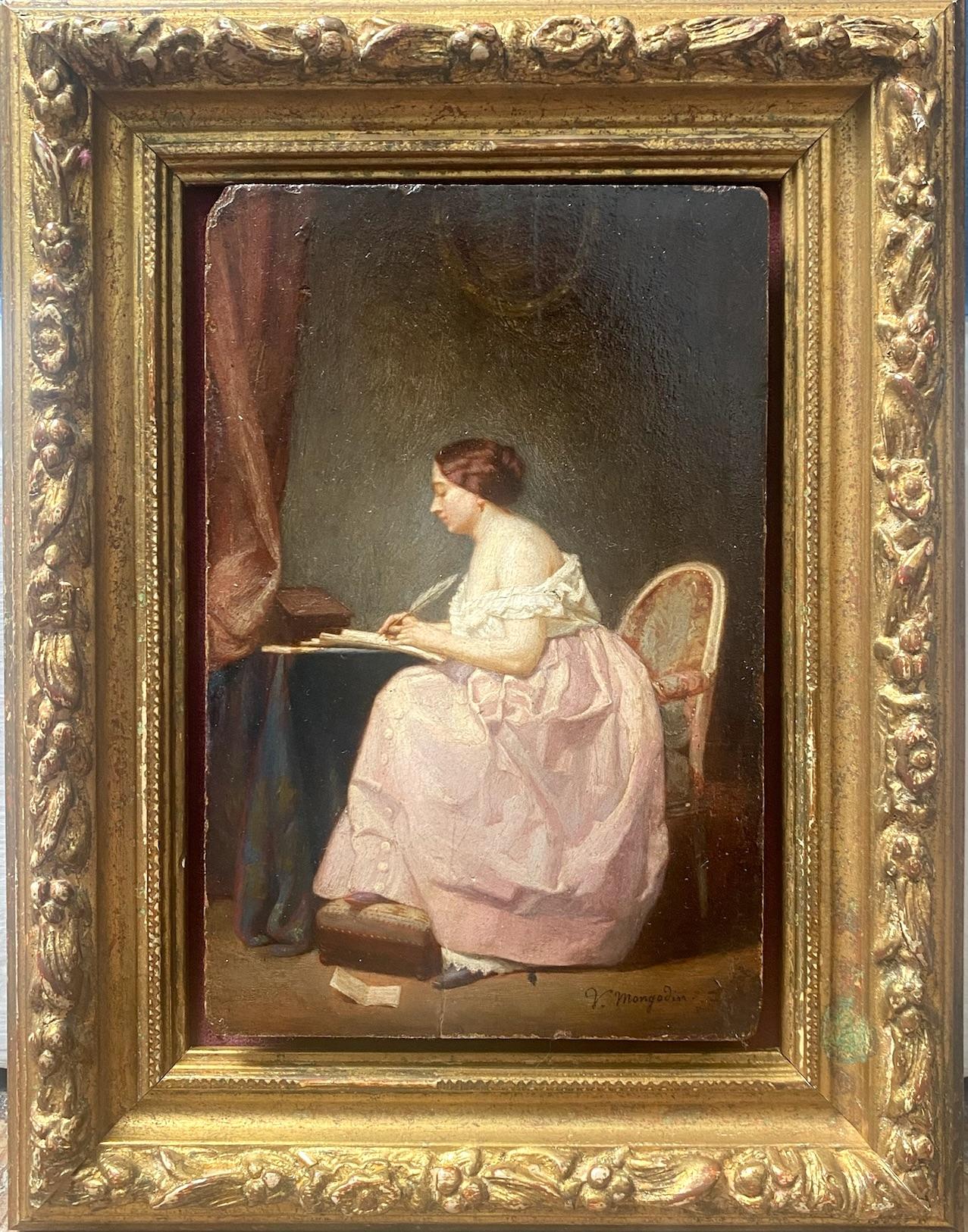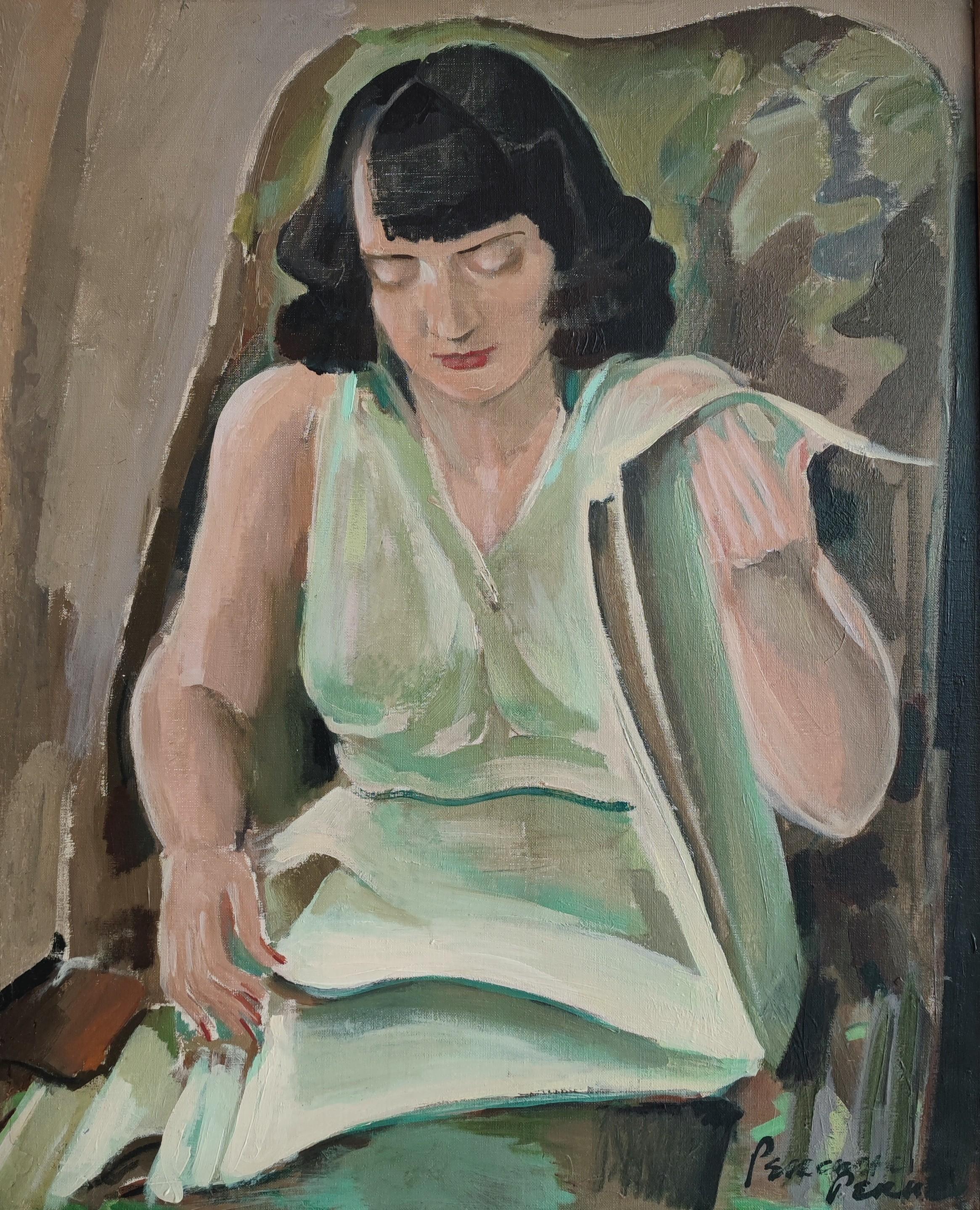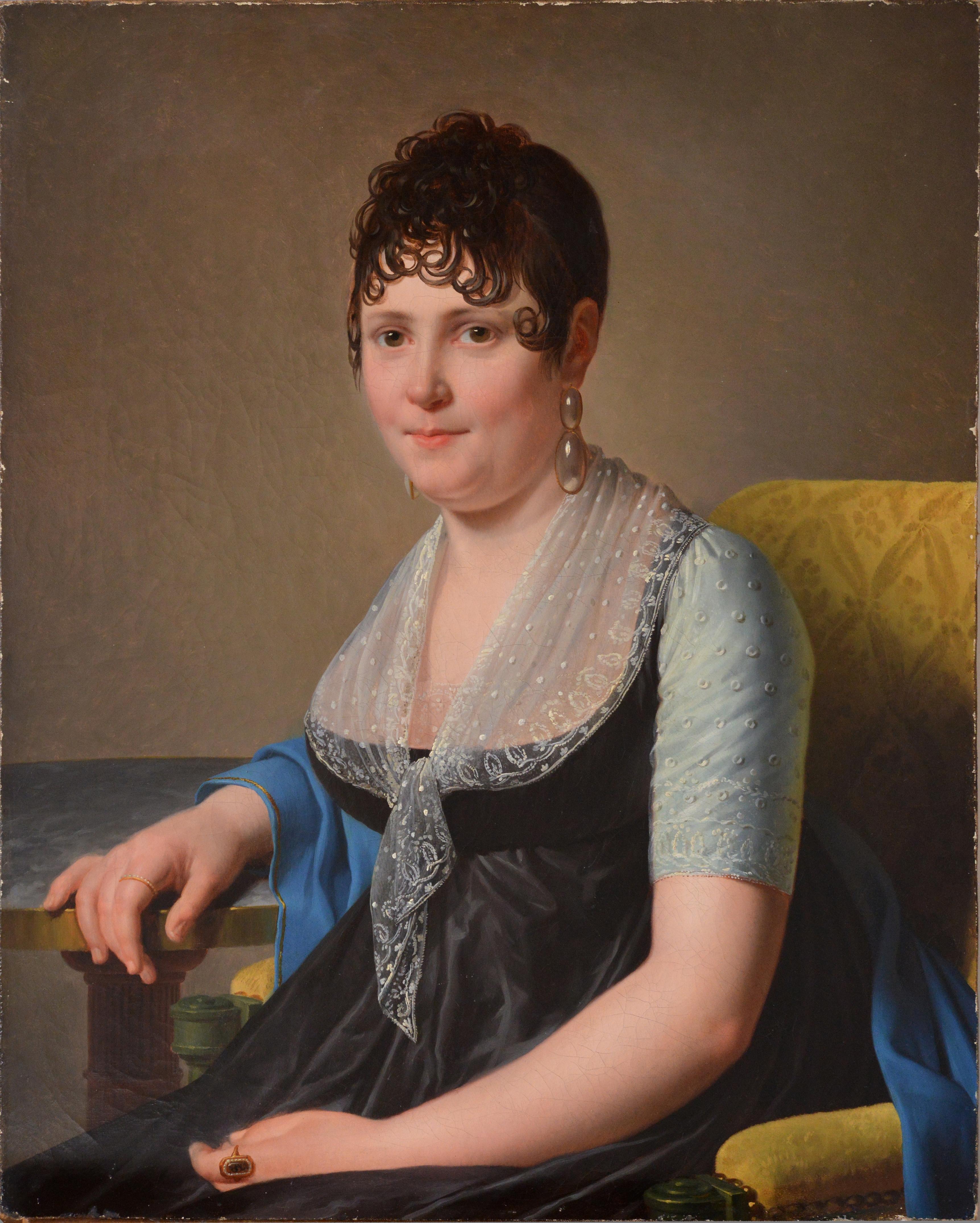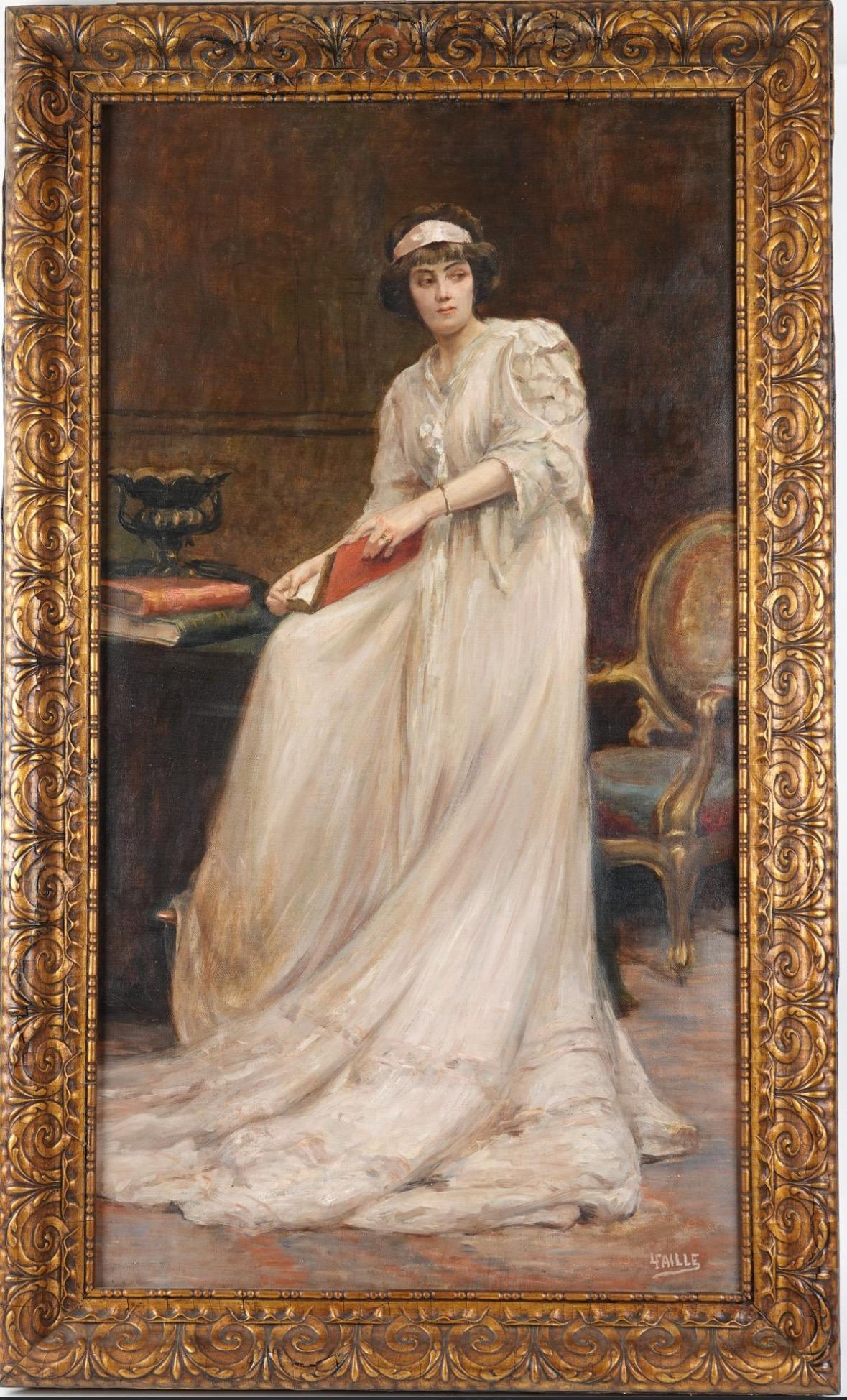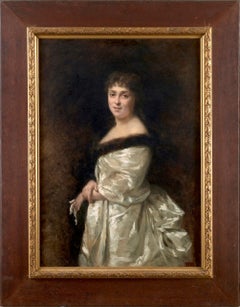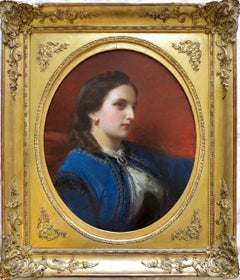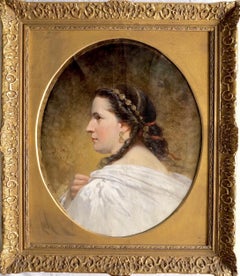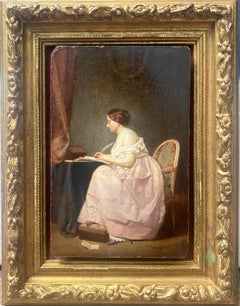Items Similar to A young woman reading a letter. Study figure
Want more images or videos?
Request additional images or videos from the seller
1 of 8
Louise HERSENTA young woman reading a letter. Study figure1812
1812
$17,972.15
£13,376.62
€15,000
CA$24,617.36
A$27,379.88
CHF 14,296.92
MX$333,183.96
NOK 182,593.49
SEK 171,240.48
DKK 114,189.76
Shipping
Retrieving quote...The 1stDibs Promise:
Authenticity Guarantee,
Money-Back Guarantee,
24-Hour Cancellation
About the Item
Louise Marie-Jeanne HERSENT, born MAUDUIT
(Paris, 1784 – Paris, 1862)
A young woman reading a letter. Study figure
Oil on canvas
Signed and dated in the middle on the right
100 x 81 cm
1812
Exhibition: Paris Salon of 1812 under number 624
Louise Mauduit is the daughter of the mathematician, professor at the Collège de France Antoine-René Mauduit (1731-1815). She was born in Paris on March 7, 1784.
Her artistic training began with an apprenticeship with the neoclassical painter Charles Meynier (1768-1832). This was followed by the teachings of the painter, student of Jacques-Louis David, Louis Hersent (1784-1862) whom she married on September 13, 1821, and to whom she owes part of her fame.
Well established as a portrait and history painter, she received various commissions from the Maison du Roi under the Restoration, including Henriette de France, Queen of England, arriving in France, currently on display in the hall of honor of the town hall of Dinan, or Louis XV visiting Peter the Great at the Hôtel de Lesdiguières on May 10, 1717, now on display at the Château de Versailles. We can then understand why Mrs. Hersent figures prominently in Heim's famous painting, Charles X distributing awards at the end of the 1824 Salon (Paris, Louvre Museum) alongside other rare female artists: Madame Haudebourt-Lescot and Madame de Mirbel.
In addition, Louise and her husband opened a private painting studio reserved for women at their Parisian home at 22 rue Cassette, the management of which she would later entrust to her best student Louise Adélaïde Desnos (1807-1878).
Louise exhibited at the Paris Salon from 1810 until 1824, where she obtained first-class medals in 1817 and 1819. Our painting was exhibited at the Paris Salon of 1812.
Mrs. Hersent died shortly after her husband in Paris on January 7, 1862, and was buried next to him in the Père Lachaise cemetery.
Several of Louise's works were translated into engravings by Ambroise Tardieu (1788-1841).
Museums: Sydney, Angers, Paris (Louvre Museum and Carnavalet Museum), Dinan, Reims, Rennes, Versailles, Dieppe, Lisbon…
- Creator:Louise HERSENT (1784 - 1862, French)
- Creation Year:1812
- Dimensions:Height: 39.38 in (100 cm)Width: 31.89 in (81 cm)
- Medium:
- Movement & Style:
- Period:
- Condition:
- Gallery Location:Paris, FR
- Reference Number:1stDibs: LU1954215109372
About the Seller
No Reviews Yet
Vetted Professional Seller
Every seller passes strict standards for authenticity and reliability
Established in 2014
1stDibs seller since 2022
13 sales on 1stDibs
Typical response time: 4 hours
- ShippingRetrieving quote...Shipping from: Paris, France
- Return Policy
Authenticity Guarantee
In the unlikely event there’s an issue with an item’s authenticity, contact us within 1 year for a full refund. DetailsMoney-Back Guarantee
If your item is not as described, is damaged in transit, or does not arrive, contact us within 7 days for a full refund. Details24-Hour Cancellation
You have a 24-hour grace period in which to reconsider your purchase, with no questions asked.Vetted Professional Sellers
Our world-class sellers must adhere to strict standards for service and quality, maintaining the integrity of our listings.Price-Match Guarantee
If you find that a seller listed the same item for a lower price elsewhere, we’ll match it.Trusted Global Delivery
Our best-in-class carrier network provides specialized shipping options worldwide, including custom delivery.More From This Seller
View AllPortrait of a worldly woman
Located in Paris, IDF
Marie Madeleine Amélie LOISEAU, born DUMONT
(Paris, 1860 - ?)
Portrait of a worldly woman
Oil on canvas
Signed and dated lower left
117 x 89 cm
1881
Exhibition: Salon de Pontoise of 1881 or 1882 under number 292
Marie Madeleine Amélie Dumont was born in Paris on January 23, 1860. She married on June 10, 1883 in Paris Mr. François Paul Raoul Loiseau, lawyer at the Paris Court of Appeal. Three children were born from this union, two girls and a boy.
Marie Loiseau was a student of Mademoiselle Espérance Langlois (active between 1860 and 1890) and Pierre Dupuis...
Category
Late 19th Century French School Portrait Paintings
Materials
Oil
Woman nestled in an armchair
Located in Paris, IDF
Joseph-Désiré COURT
(Rouen, 1797 – Paris, 1865)
Woman nestled in an armchair
Oil on canvas
Signed and dated lower left
81 x 65 cm
1834
Exhibition: in all likelihood, number 50 of ...
Category
Mid-19th Century French School Portrait Paintings
Materials
Oil
Portrait of Mary Augusta de La Barre de Nanteuil (1836 – 1862)
Located in Paris, IDF
Charles-Édouard Boutibonne
(Pest, 1816 – Wilderswil, 1897)
Portrait of Mary Augusta de La Barre de Nanteuil
(New York, 1836 – Saint-Brieuc, 1862)
Oil on oval canvas
Signature and d...
Category
Mid-19th Century French School Portrait Paintings
Materials
Oil
Portrait of Madame Hermann-Joseph REINACH, born Julie BÜDING (1828-1870)
Located in Paris, IDF
Frédéric Adolphe YVON
(Eschviller, 1817 – Paris, 1893)
Portrait of Madame Hermann-Joseph REINACH,
born Julie BÜDING (1828-1870)
Oil on canvas
Signed and dated on the left
65 x 54 ...
Category
Late 19th Century French School Portrait Paintings
Materials
Oil
Portrait of Mr. Pierre Rougé and portrait of Mrs. Mathilde Rougé, born Rauch
Located in Paris, IDF
Adélaïde SALLES-WAGNER
(Dresden, 1824 – Paris, 1890)
Portrait of Mr. Pierre Rougé
Portrait of Mrs. Mathilde Rougé, born Rauch
Pair of oils on canvas
Signed lower right for one and ...
Category
Late 19th Century French School Portrait Paintings
Materials
Oil
People's woman of Venice, Italy
Located in Paris, IDF
Henri Auguste Cesar SERRUR
(Lambersart, 1794 – Lille, 1876)
People's Woman of Venice
Oil on canvas
Signed, located and dated
65 x 60 cm
Venice 1850
Exhibitions:
- Paris Salon of 1...
Category
Mid-19th Century French School Figurative Paintings
Materials
Oil
You May Also Like
The Letter, young lady in her boudoir 19th Century majestic miniature painting
Located in Norwich, GB
A majestic miniature painting by Victor Mongodin. Painted with extraordinary detail, it depicts a pretty young lady writing a letter in her boudoir. Mongodin clearly delights in painting fabrics... the silk of her skirt, the cotton of her camisole, as well as the luxurious velvets of the curtains and drapery. And then there is the mystery: who is she writing to?
Born in Vire in Normandy in 1819, Victor Mongodin had studied with de Rudder. Working in the French Capital...
Category
1860s French School Interior Paintings
Materials
Oil, Wood Panel
LADY READING - French School - Figurative Italian Oil on canvas painting
By Giovanni Santaniello
Located in Napoli, IT
Lady Reading - Figurative oil on canvas painting cm.80x60, Giovanni Santaniell, Italy 2002
In this painting, Giovanni Santaniello drew inspiration from t...
Category
Early 2000s French School Figurative Paintings
Materials
Canvas, Oil
Young woman reading
Located in Genève, GE
Work on canvas
Fluffy brown wood frame
76.5 x 63.5 x 3 cm
Category
Mid-20th Century Figurative Paintings
Materials
Oil
Study of a girl sitting and reading a book
By William Hoare
Located in Bath, Somerset
A study in red chalk of a girl sitting and reading a book. Red chalk on paper under glass in a giltwood and gesso frame. This small drawing has a sense of intimacy in the capturing of a moment where the sitter is seemingly unaware of being observed, unlike the feeling of formailty and self-awareness in a staged portrait sitting
Provenance:
Private collection, Somerset
With J. Davey & Sons Ltd, Liverpool
William Hoare...
Category
Late 18th Century English School Figurative Drawings and Watercolors
Materials
Paper, Chalk, Glass
$2,192 Sale Price
20% Off
French Portrait Mysterious lady 19th century Oil painting Acknowledged master
Located in Stockholm, SE
Unsigned but attributed to acknowledged master Francois-Xavier Fabre (François-Xavier Fabre, 1766 – 1837), French painter of historical subjects. Stylish and perfect portrait of beau...
Category
1820s French School Portrait Paintings
Materials
Canvas, Wood, Oil
Very Fine 1900's French Signed Oil Full Length Portrait Lady Reading in Interior
Located in Cirencester, Gloucestershire
Portrait of a Lady, reading in an interior
circa 1900-1920 period
by Louis Faille (French 1878-1964)
signed lower right corner
oil painting on canvas,
framed in original gilt, mould...
Category
Early 20th Century Impressionist Portrait Paintings
Materials
Canvas, Oil
More Ways To Browse
Signed Louise
Queen Louise
19th French Portrait Woman
Chateau De Versailles
Marie Versailles
19th Century French Female Portraits
Portrait Of Louis Xv
Lisbon Antique
Versaille Engraving
Organ Grinder
C Freeman Oil Painting
Elizabeth Spencer
Lord Nelson Painting
Steve Kaufman Marilyn
Christina Aguilera
Fiddler On The Roof
Frederick Philips
Michel Debieve
